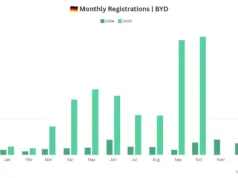Most investors see BYD as a Chinese EV powerhouse, but there’s much more under the hood.
When investors look at the electric vehicle (EV) landscape, BYD Company (BYDDY +0.00%) is often seen as a manufacturing powerhouse. But beneath the headlines about scale and exports lies a more nuanced story.
The company isn’t standing still with its manufacturing prowess. It’s quietly turning its operational edge into a broader technology and energy ecosystem that could surprise investors who have written it off as a volume-driven automaker.
Here are three underappreciated reasons BYD might still have room to surprise the bears.

Image source: Getty Images.
Software, intelligence, and mobility platform upside
For years, automakers have been hardware businesses — build the vehicle, sell it, and move on. BYD had the same business model but is gradually evolving away from it. The company has built an integrated software and intelligence layer that stretches across its lineup, from budget to luxury models.
It began rolling out its proprietary BYD OS in 2023, built on its e-Platform 3.0 architecture. The system decouples hardware and software, enabling faster updates, smoother integration, and high-level autonomy features.
In early 2025, BYD went a step further, launching its «God’s Eye» advanced driver-assist system (ADAS) across 21 models in China. Crucially, not just the premium models but also the non-premium models have the software. Think of it as the equivalent to Tesla‘s full self-driving (FSD) system, but at no extra cost to the owner.
This strategy matters because it expands the company’s potential revenue levers:
- Software-driven features can offset margin pressure from price cuts.
- Connected vehicles open the door to recurring revenue through upgrades, subscriptions, and data services.
- Over time, a unified operating system creates ecosystem stickiness — the more cars running BYD OS, the higher the switching costs.
Investors often underestimate how BYD’s in-house software evolution could reshape its long-term margin profile. Maybe they should start paying more attention now.

BYD Company
Today’s Change
(0.00%) $0.00
Current Price
$0.00
Key Data Points
Market Cap
$0B
Day’s Range
$0.00 – $0.00
52wk Range
$0.00 – $0.00
Volume
0
Avg Vol
0
Gross Margin
0.00%
Dividend Yield
N/A
Energy and storage ecosystem — beyond the car
While EVs grab the spotlight, BYD’s roots in battery manufacturing give it a broader reach into the global energy transition. The company is already one of the largest suppliers of stationary energy-storage systems globally. For instance, BYD Energy Storage and Saudi Electricity Company signed the world’s largest grid-scale energy storage project contracts with a capacity of 12.5GWh early this year.
That diversification matters for BYD. Even if car margins come under pressure, the energy segment can act as a stabilizer. BYD’s battery technology is now being deployed in solar-to-storage-to-mobility solutions, linking household solar, home batteries, and electric vehicles into a single ecosystem.
Few automakers have this level of vertical connectivity. Another company with a similar business diversification is Tesla. For BYD, it’s not just about making EVs — it’s about powering and storing the energy that drives them. As global grids modernize and demand for renewable storage accelerates, BYD’s energy segment could quietly become an important growth engine.
Solid execution track record
BYD may be a high-growth company, but it’s also disciplined. Unlike many EV peers that rely heavily on external capital, BYD funds most of its expansion through reinvesting its profits. For instance, it has been profitable over the last five years, with net profit growing almost tenfold — from 4 billion yuan in 2020 to 40 billion yuan in 2024 (around $6 billion) — reflecting the strength of its core operations.
That financial strength gives it room to maneuver — to keep investing in research and development (R&D), scaling production, and localizing manufacturing without constant equity dilution. CEO Wang Chuanfu, who still holds a meaningful stake, runs the company with a long-term builder’s mindset.
This track record matters for investors. In an industry filled with capital-hungry start-ups, BYD’s ability to grow, self-fund, and stay profitable is a differentiator. It also means that the company can endure price wars and policy shifts better than its peers.
What does it mean for investors?
BYD isn’t just another EV manufacturer. It’s about building a foundation that integrates software, hardware, and energy into a single, scalable ecosystem. For investors, the key questions are simple:
- Will BYD successfully monetize its growing software base?
- Can its energy-storage business become a meaningful profit driver?
- And will its operational discipline continue to protect margins during the next down cycle?
If the company makes meaningful progress on these fronts, BYD could quietly evolve from a low-cost champion into a full-stack mobility and energy platform. Above all, it could be what the growth investors are looking for now.









